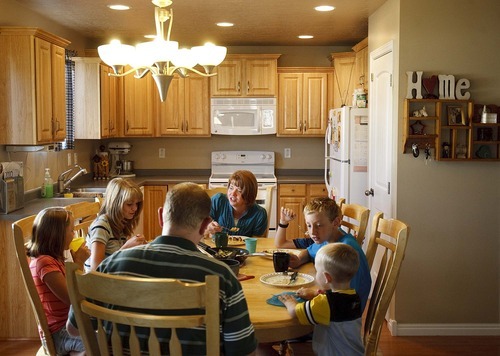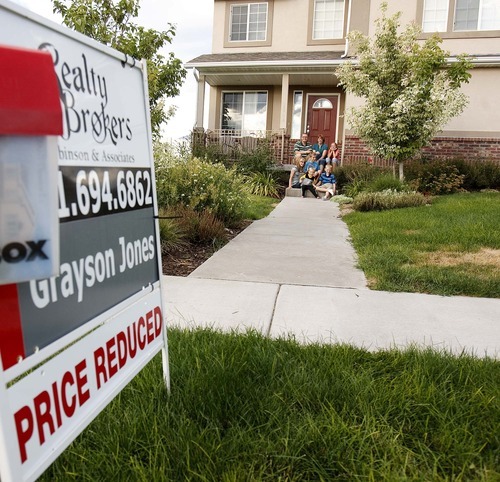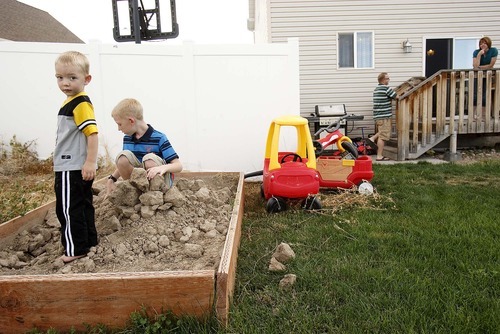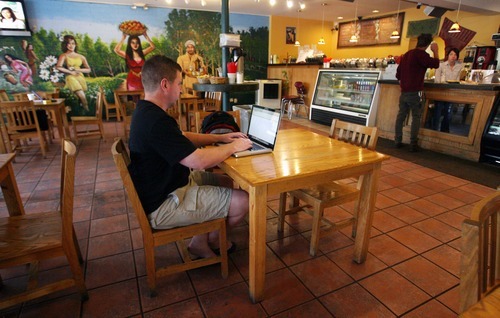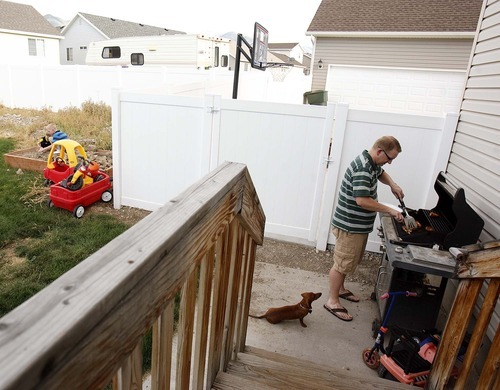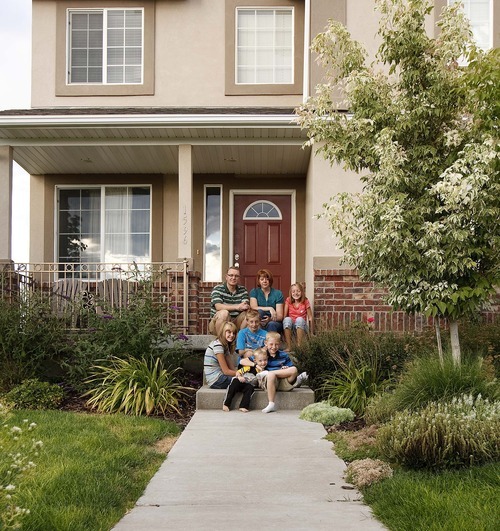This is an archived article that was published on sltrib.com in 2011, and information in the article may be outdated. It is provided only for personal research purposes and may not be reprinted.
As bad as the recession and feeble recovery have been to Utah's psyche, the biggest meltdown since the 1930s has laid bare a more sinister plight — our middle class is slipping backward.
It may be hard to see. The counties along the Wasatch Front, home to three of every four Utahns, look the same as they did during the boom years, when the stock market and housing bubble fueled the impression that most families were doing well in spite of incomes that barely budged.
In hindsight, the impression may have been an illusion. Empirical evidence and Utahns' responses to a Salt Lake Tribune opinion poll in which most described themselves as middle class show that their financial foundations are eroding, the rich-poor gap is widening and most believe that their elected officials lack the ability to fix the economy.
According to the recent survey conducted by Mason-Dixon Polling and Research Inc:
• Utahns feel stuck in their tracks. One in three has lost ground in the past five years — a fact certified by the Census Bureau. Adjusted for inflation, median Utah household incomes fell to $58,491 in 2009 from $59,226 a decade earlier.
• Incomes have fallen in one-third of respondent households, even though two-thirds (63 percent) have at least two wage earners contributing income.
• Close to one in three of the respondents said someone in their household has lost a job in the past five years, while similar percentages of Utahns are struggling with debt or fear they won't have enough savings to retire comfortably.
"I feel a sense of hopelessness, and I'm the most optimistic person I know," said Marcia Timmins, a Herriman business owner whose income has fallen almost by half since 2008. "Middle-class security is long gone. People are depressed. It's like Russia in the winter of 1916."
• More than half of respondents (52 percent) have lost faith in the stock market as a way to build wealth. The Dow Jones industrial average was at 11,357 at the start of 2000. The Dow Friday was at 11,240.
• More than one-third (36 percent) think their status inside the middle class is declining.
• Of the respondents who identified themselves as middle class, just 9 percent said their class status is improving. Another 36 percent said their status is declining. In other words, for every one person who said they continue to climb up the ladder, four worry that they're headed down.
"The trends are clear. The rates are clear," said Andrew Jorgenson, a University of Utah sociology professor. "The middle class is in trouble, without a doubt."
—
Who is middle class? • Most people think they are middle class, an intuition TheTribune's sample of Utahns supports. Only 30 percent of respondents placed themselves in social groups "above" or "below" middle class. That said, although they identify themselves as being in the social group between the lower and upper classes, no single gauge of what the middle class is seems to prevail.
Economists think income is the best measure, although there is no definitive standard. A distribution of annual household incomes devised by the Tax Policy Center, a nonpartisan think tank, this year put the midpoint at $42,327 (25th percentile was $19,375; 75th was $85,811; and 99th was $506,553).
Mark Knold, chief economist at Utah's Department of Workforce Services, thinks entry into the middle class in Utah probably starts around $40,000 a year, enough to afford a house and a family, but little else. On the other side, the gateway to the high life likely begins at $120,000, he said.
"I think that's representative, but I don't know if everybody would agree," Knold said. "When they say middle class, it's kind of an idea. It's not someone struggling with their money, but on the other hand they don't have a lot left over for luxuries."
For the reason that education is strongly correlated with income, schooling is another measure. Numerous studies have found that people with higher incomes frequently have more years of education.
As much as income and education, though, the concept of middle class may be a psychological construct. Middle-class Americans have a larger measure of financial independence than the poor. And although they vote, they don't have as much political clout as the rich or super-rich — the top 20 percent of Americans who possess 85 percent of U.S. wealth.
—
Deeper economic worries • The source of Utah's middle-class anxiety goes beyond the recession to a deeper economic reality — of the world's developed democratic countries, the United States has the highest level of income inequality, according to the CIA and the World Bank. Edward Wolff, a New York University economist, says the top 5 percent of U.S. households own 62 percent of the nation's wealth, while the bottom 40 percent own almost none.
That is hardly trivial. Income inequality is a standard for assessing the health of a country's economy, as well as the well-being and standard of living of its citizens. According to the CIA, which assesses such matters as part of its intelligence gathering, the extent of household income inequality in the U.S. is on par with:
• Jamaica, where economic growth is threatened by high crime, corruption and widespread joblessness;
• Ivory Coast, racked by a civil war since 2002;
• And Iran, whose state-directed economy is hobbled by high inflation and unemployment.
Edmund Bench, a 66-year-old Duschene County farmer, has watched the arc of America's metamorphosis from post-World War II agricultural and industrial giant to a service-oriented economy that has exported its manufacturing jobs overseas. The result, he believes, has been downward mobility for millions of Americans.
"We've lost so many good-paying jobs," Bench lamented.
Gerald Gunning also sees America's economy backpedaling. The 62-year-old South Jordan manager at a brick manufacturing business has had his pay cut and bonuses reduced, and he's not alone. Some of his high-income friends have fallen into the middle class. Others have fallen out.
Everything costs more, even though the government insists that inflation is tame, he said. Retirement, which was once just around the corner, is on hold until he is at least 70 or until his stock portfolio rallies.
"It's more than just the stock market," Gunning said. "It's everything. People are slipping down."
—
Utah better than most but ... • Despite all the angst, Utahns are comparatively better off than other Americans. Income inequality is lower than in any other state except Alaska, according to the Census Bureau. Compared to other states, Utah's wealth is spread more equitably across the population.
But the distribution of assets has been growing steadily less egalitarian for at least three decades, and the resulting signs of pain are far and wide:
• Adjusted for inflation, the median income of Utah households fell from 1999 to 2009, Census Bureau figures show.
• Bankruptcies filed by Utahns last year were up 24 percent from 2009 (when the recession officially ended), according to bankruptcy court records.
• About one-quarter of homeowners in Salt Lake City are either "underwater" — meaning they owe more than their homes are worth — or are getting close, according to housing data firm CoreLogic.
• The average Utah household's revolving debt — credit that doesn't have to be paid off each month but gathers interest when it isn't — was $7,700 in 2007, according to the Utah Foundation. In 1980, the figure was $1,600.
"This country is a little lost right now," said West Valley City resident Ruth Anderson, whose husband, Brett, a cabinetmaker, lost his job after the Wasatch Front construction boom tanked four years ago.
The Andersons are trying to start over. Past 50, Brett isn't sure what occupations may be open to him that he could afford to train for, or that even would allow him to work for another decade or two.
The couple gets by on what she earns at a distribution warehouse and the temporary jobs her husband finds. But it takes two incomes to pay their bills, which include installments on a home loan. Their house, bought in 2007 at the top of the market, today is worth $45,000 less than the amount they borrowed. They have been able to obtain a loan modification, which lowered their interest rate more than 3 percentage points.
"I keep paying the mortgage," Ruth Anderson said. "But now, it's just a place to live."
—
Luxury no more • Even as many Utahns fight to keep up, the economic pressure builds. In a 2009 study, British epidemiologists Richard Wilkinson and Kate Pickett discovered that rising levels of inequality are connected to a range of social ills, from crime and obesity to mental illness and teen pregnancies.
In Utah, the number of obese adults doubled from 1989 to 2009. One in four adults is significantly overweight, according to the Utah Department of Health. Teen birth rates in Utah are as much as five times higher than rates for many European countries.
Also, unlike many European countries, and even some U.S. states, at least 300,000 people in Utah are without health insurance. (Massachusetts mandates that individuals buy health insurance; in May, Vermont's governor signed a bill establishing universal insurance coverage for all residents.)
Keith Sorenson isn't among the state's residents whose health care is covered by insurance. At 64, the retired construction-management consultant qualifies for Medicare. Sorenson also has supplemental insurance for his wife and himself.
That is cold comfort, though. Not long ago, Sorenson's annual income exceeded $200,000. At times, it reached $300,000. Then, because of heart problems, he was forced to retire early. And because several investments went bad, his income was slashed. Today, the Sorensons live in Farmington on 10 percent of his former earnings. He is looking for a job to defray the escalating cost of necessities eating into the household budget. Just to pay for prescriptions, insurances and the like requires 25 percent of his income, he said.
"When you once enjoyed the luxury of buying and having almost anything you want, and now when you go to the grocery store you have to be careful about what you buy, it's an entirely different story," Sorenson said.
—
No quick end • Not all poll respondents are falling backward. Four in 10 are in the same place financially as five years ago. Another 27 percent are better off.
Nancy Gough, 44, derives no pleasure from having tread water since 2006. She and husband Justin have kept the family budget in balance by watching their spending and building savings. Except for their mortgage and some student loans, the Goughs are debt-free.
"We are really careful with what we purchase and what we do. We don't do anything extravagant," said Gough, a medical assistant and mother of three. "We did a 'staycation' this year. Normally we go spend a week in Yellowstone, but this year we did more local things. The cost of gas was too high."
Still, it's hard to get ahead, she said. Several years ago, Nancy enrolled in nursing school. She will graduate in three months, but the recession has ended the shortage of registered nurses.
"I hope I get a job quickly," Gough said.
It is hard to see a quick end to Utah's plight. The problems facing the middle class have festered for years through indifference from politicians and the public. None, not a single one, of the 625 registered voters surveyed for The Tribune's poll said they were "very confident" that the nation's elected officials have the skills or temperament to take the right steps to help improve the U.S. economy.
"I'm living the American Dream," said Jaren Angerbauer, 43, of Holladay, who was laid off in December 2008. "Minus the financial stability and the benefits you get for working for a company."
pbeebe@sltrib.com Twitter: @sltribpaul
lesley@sltrib.com Twitter: @cheap chick —
Where to get financial help
Call 211 and ask for a community counseling service in your area.
AAA Fair Credit Foundation offers free and low-cost counseling along the Wasatch Front. Faircredit.org or 800-351-4195.
Cornerstone Financial Education offers free and low-cost counseling and financial education in the Ogden area. Csfedu.org or 800-336-1245.
Community Action Services offers a variety of counseling services and financial education courses in the Provo area. Communityactionuc.org or 801-373-8200.
Go to 1.usa.gov/e7XR1p for programs and counseling programs available to those behind on their mortgage or who are facing foreclosure. 0% None, not a single one, of the 625 registered voters surveyed for The Tribune's poll said they were "very confident" that the nation's elected officials have the skills or temperament to take the right steps to help improve the U.S. economy. —
Higher prices for necessities definitely are taking a bigger bite out of Utahns' pocketbooks — so much so that for many it's their top financial concern.


